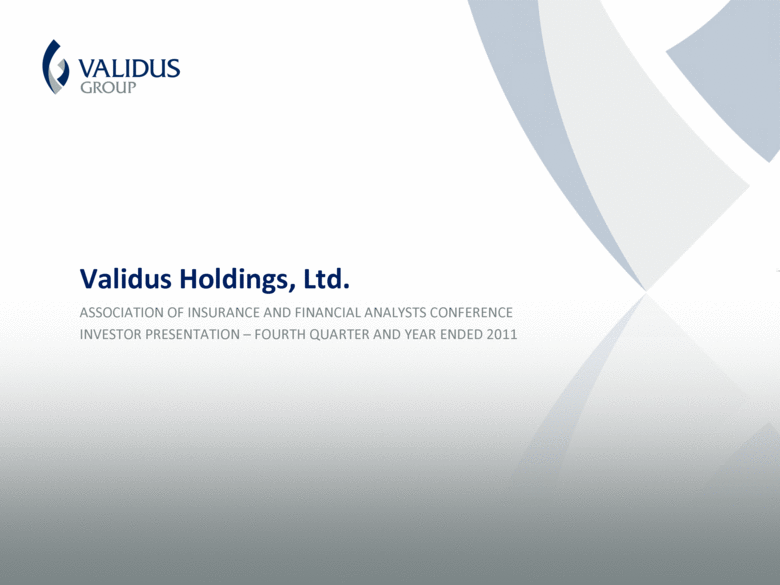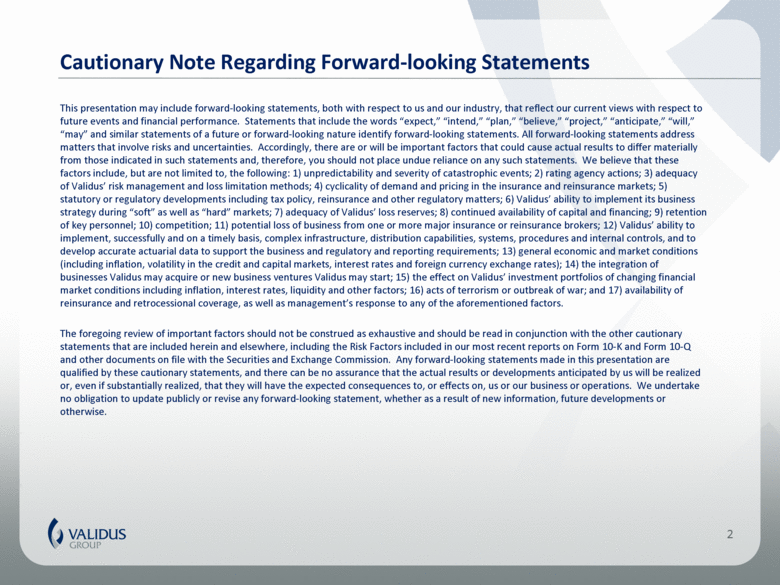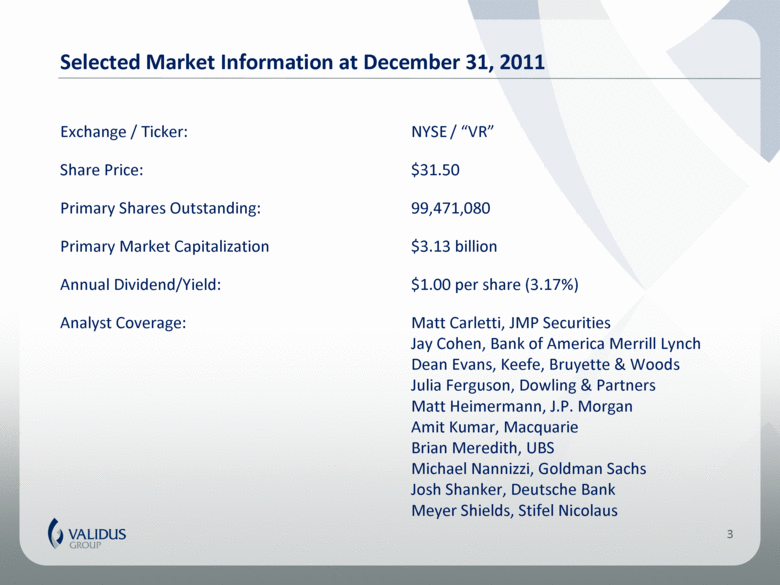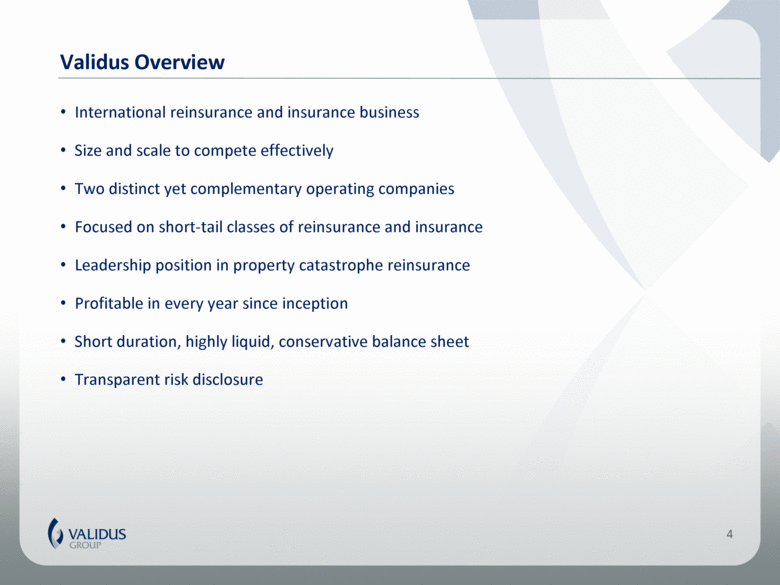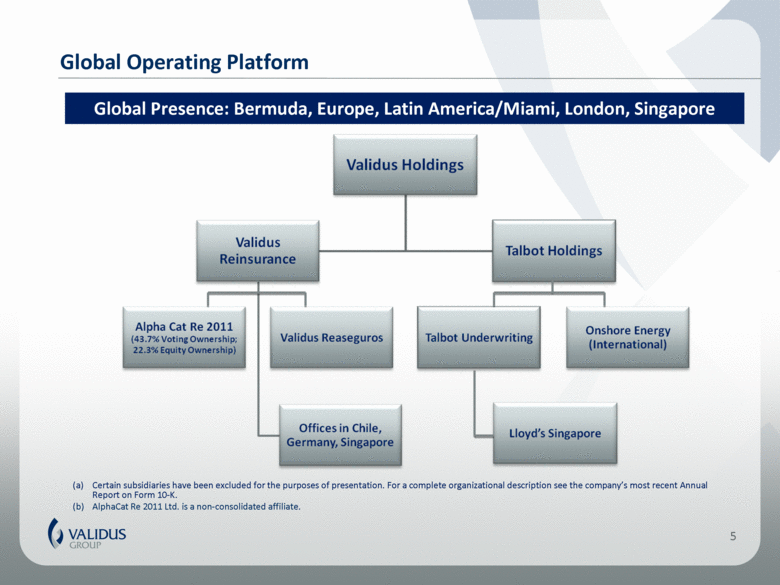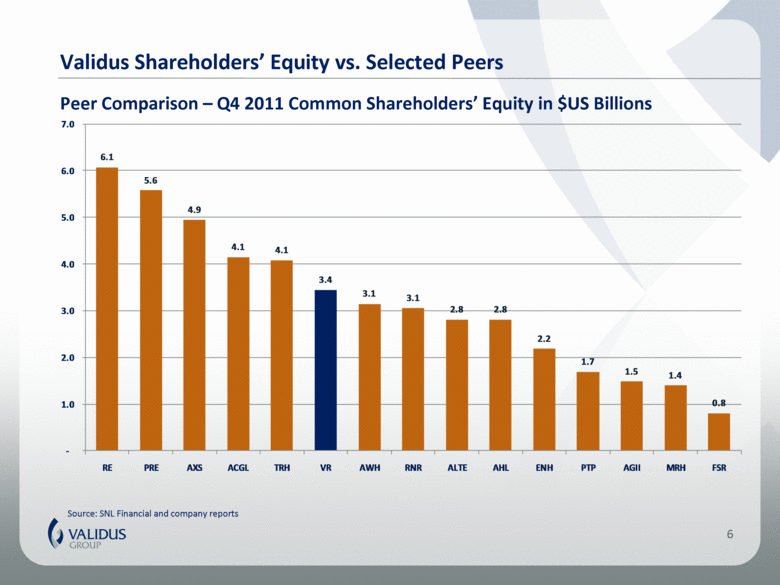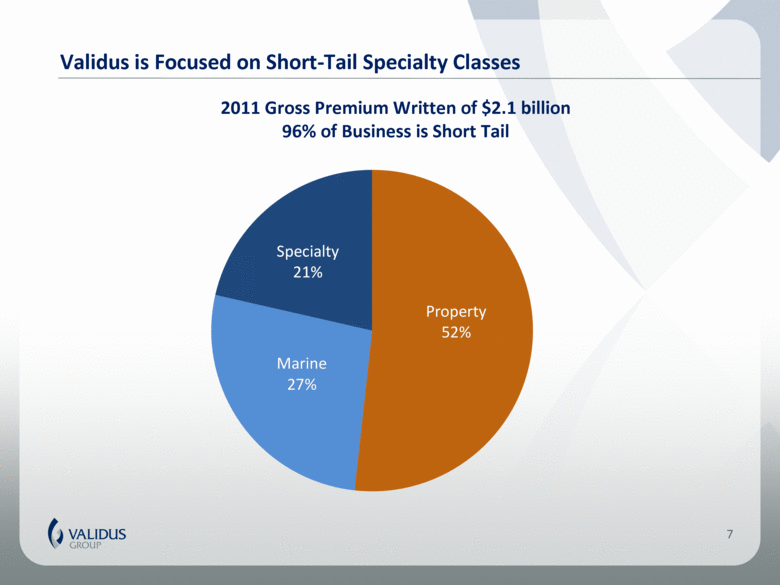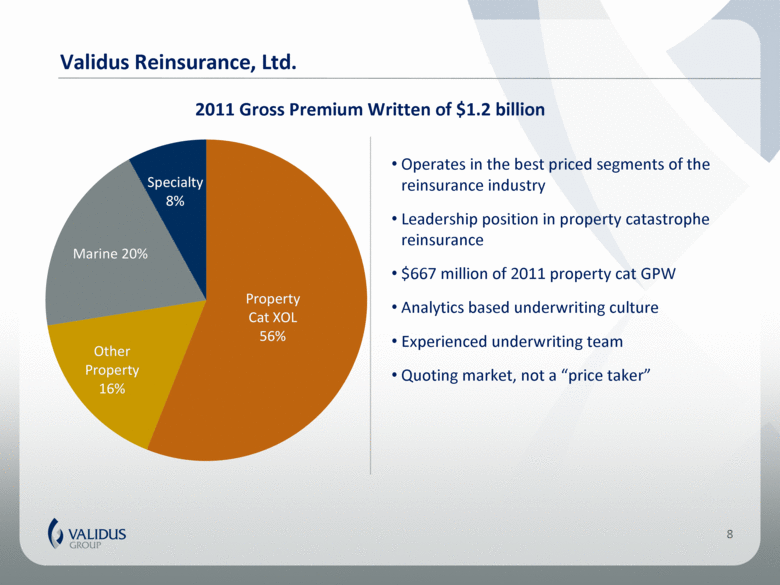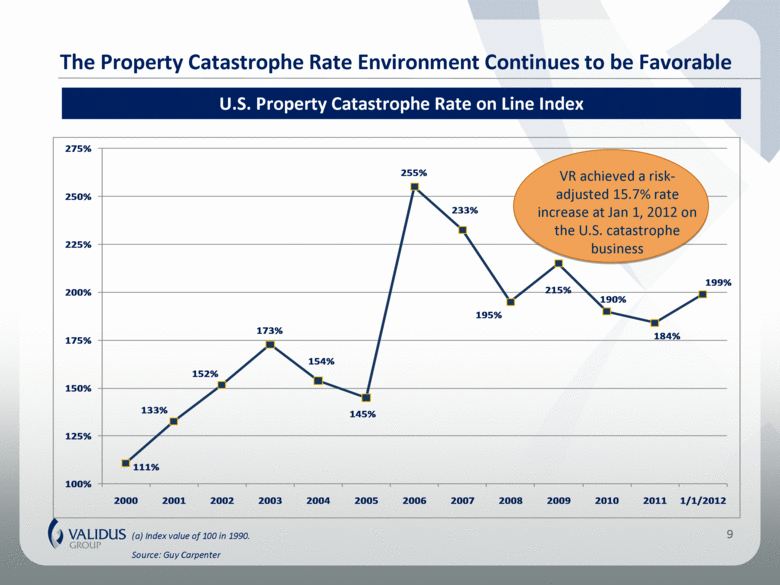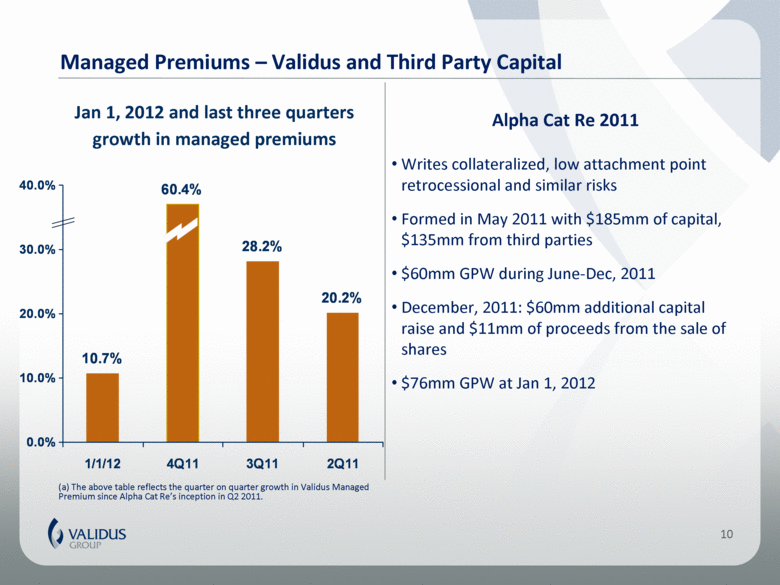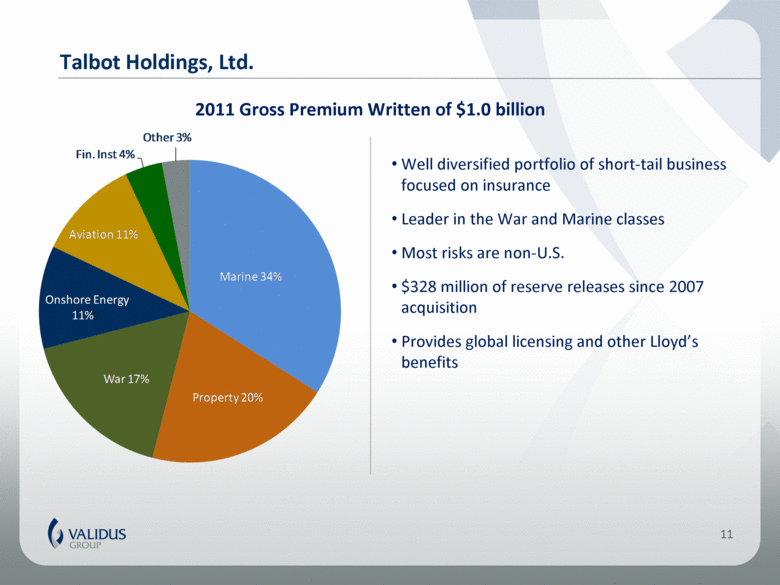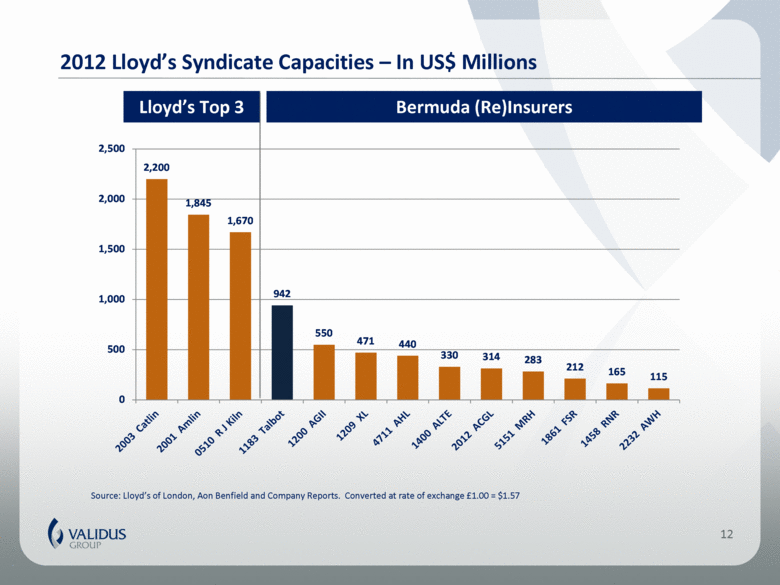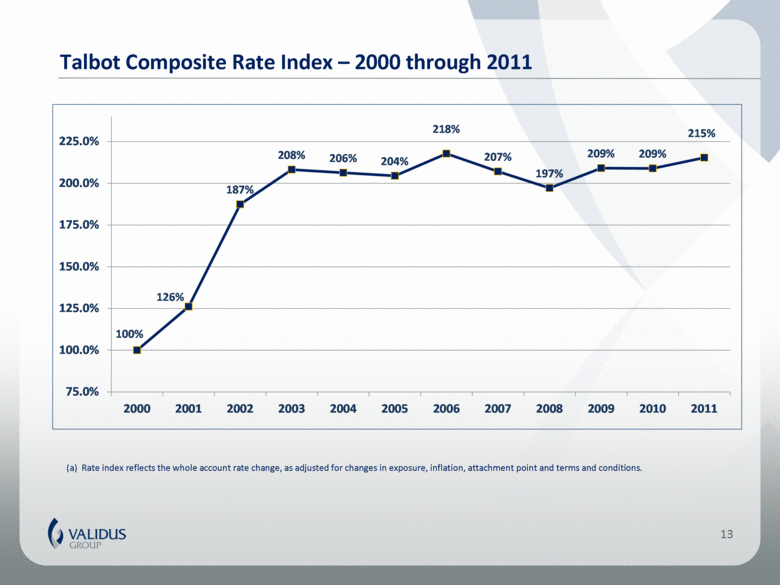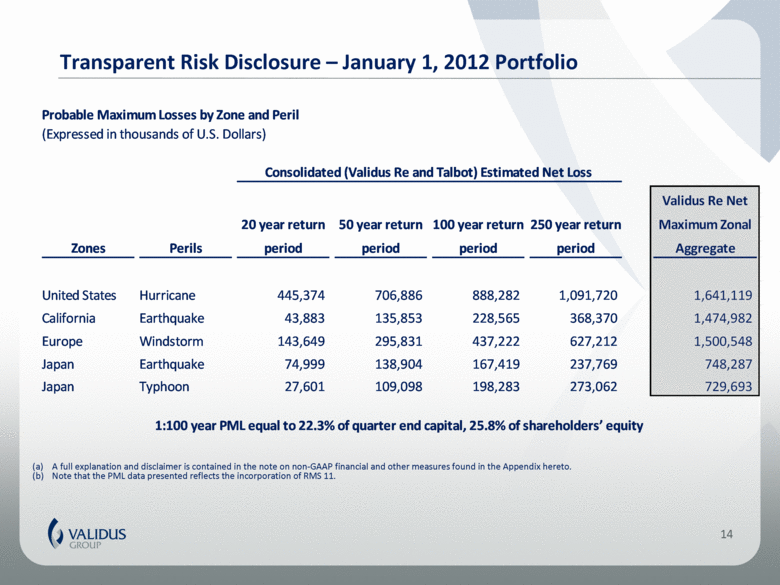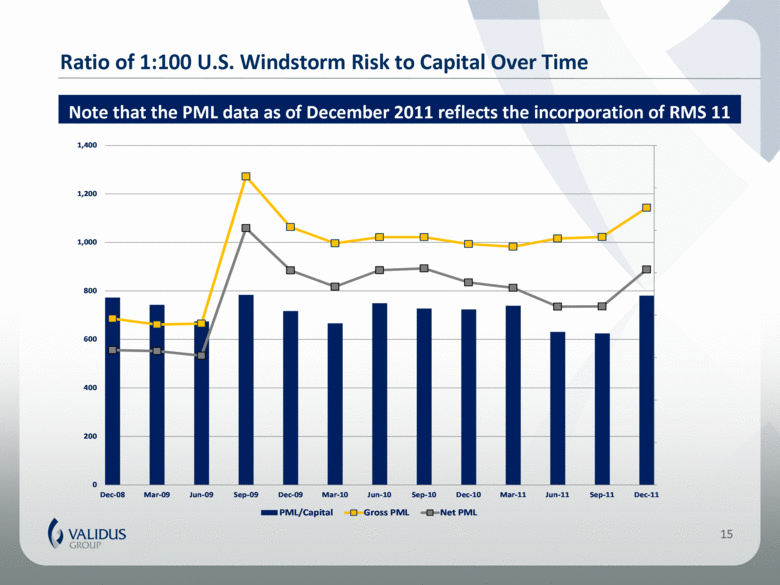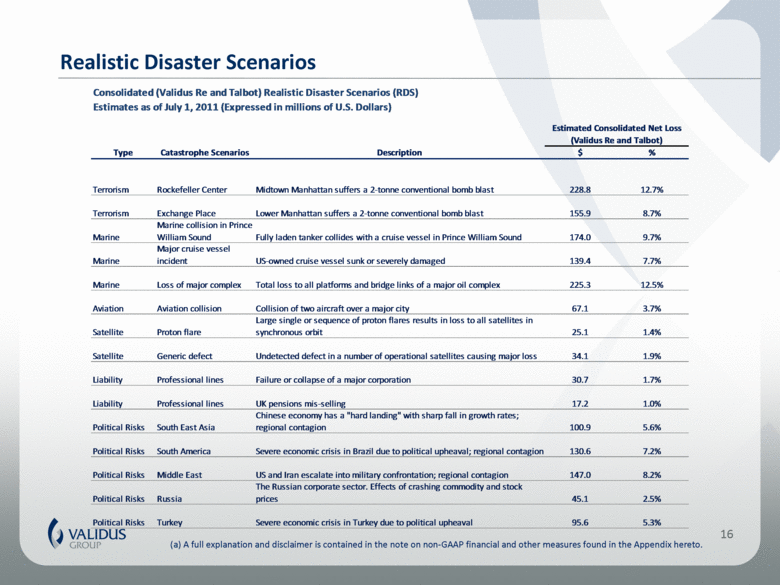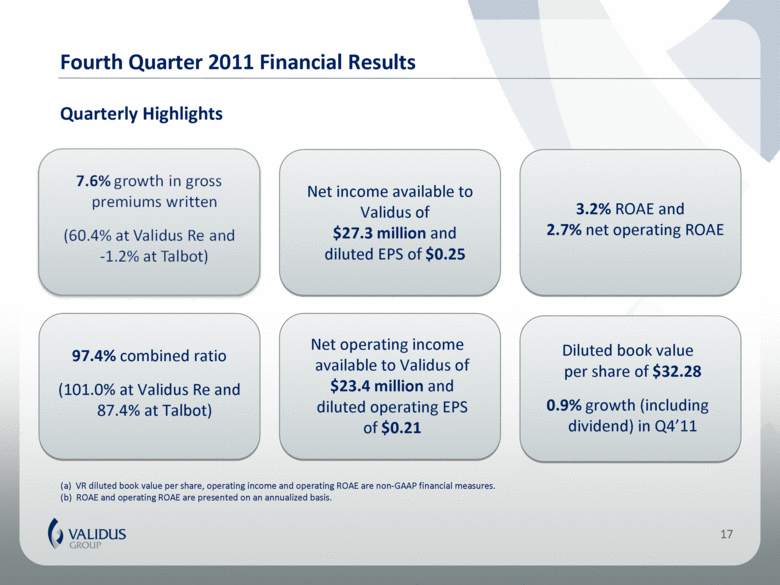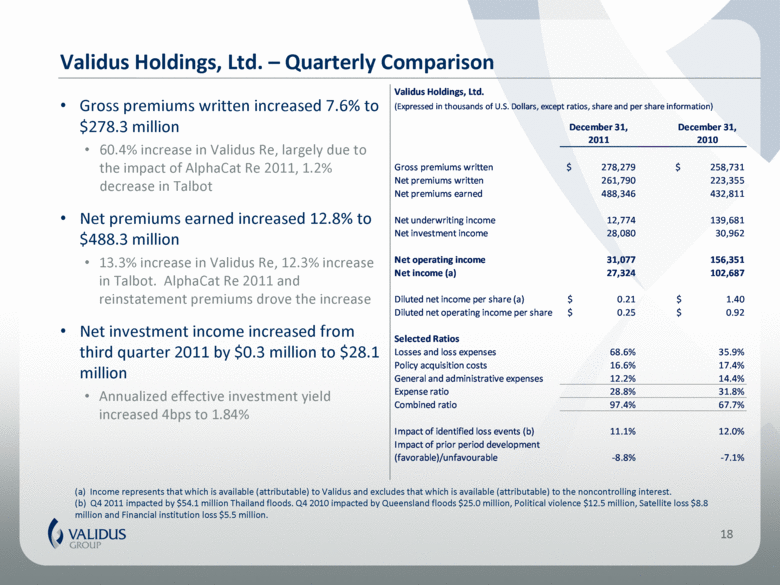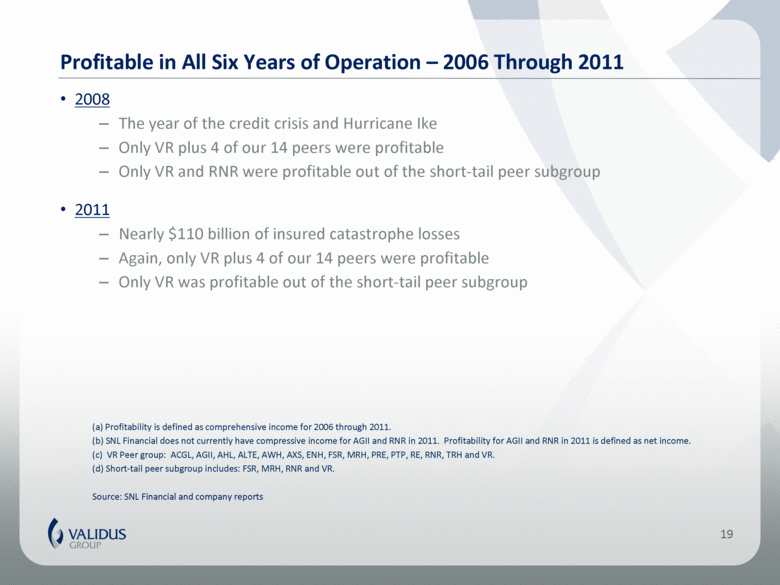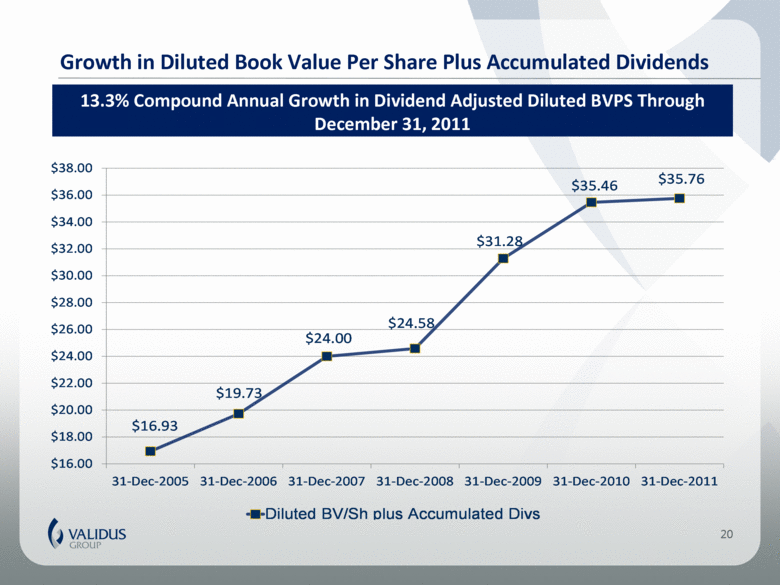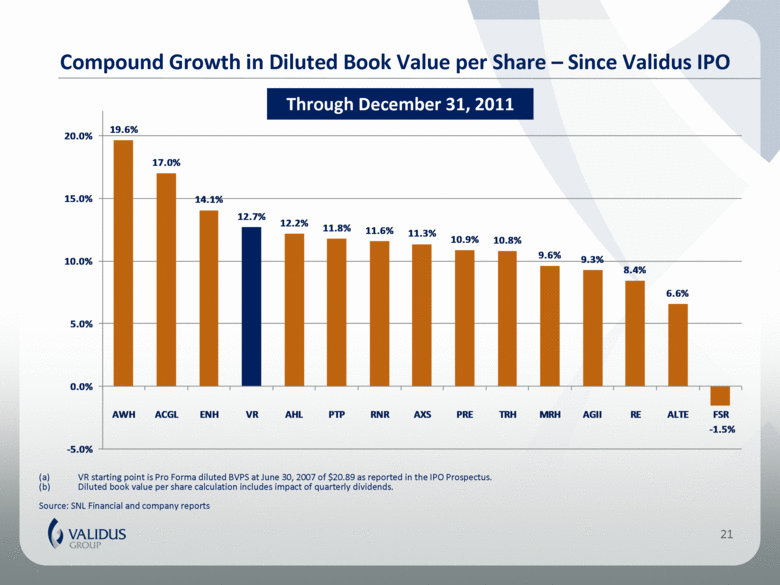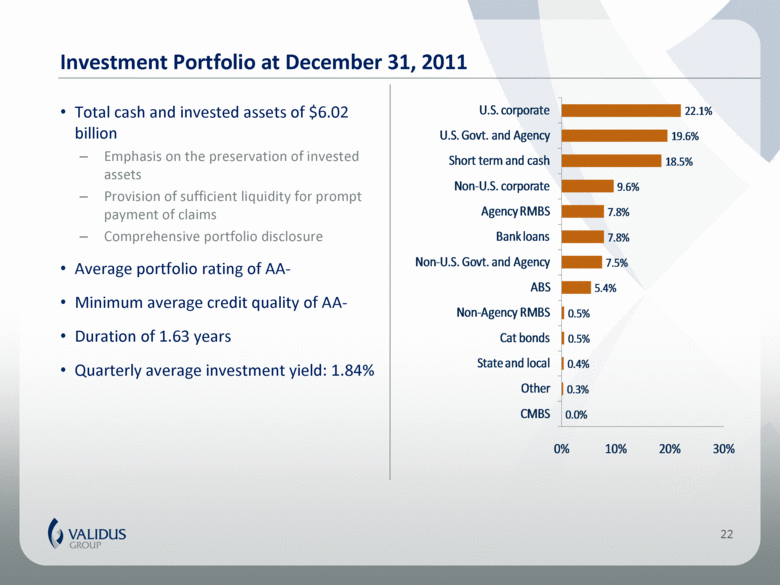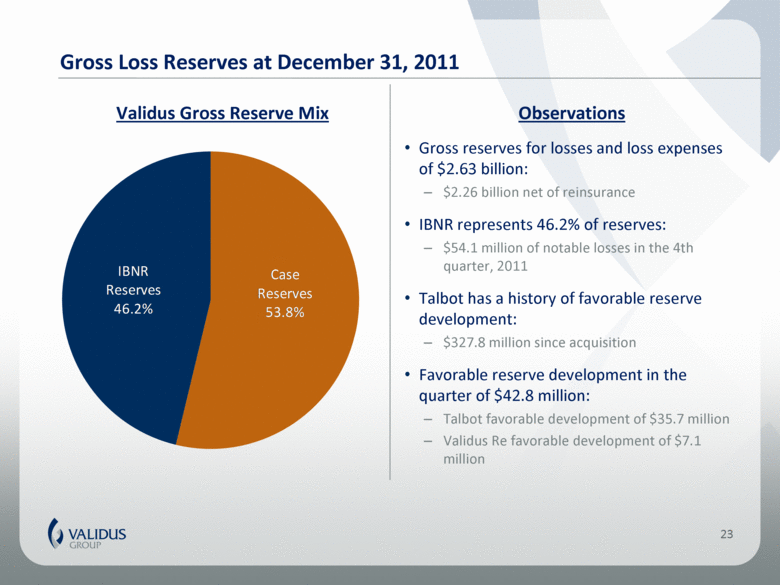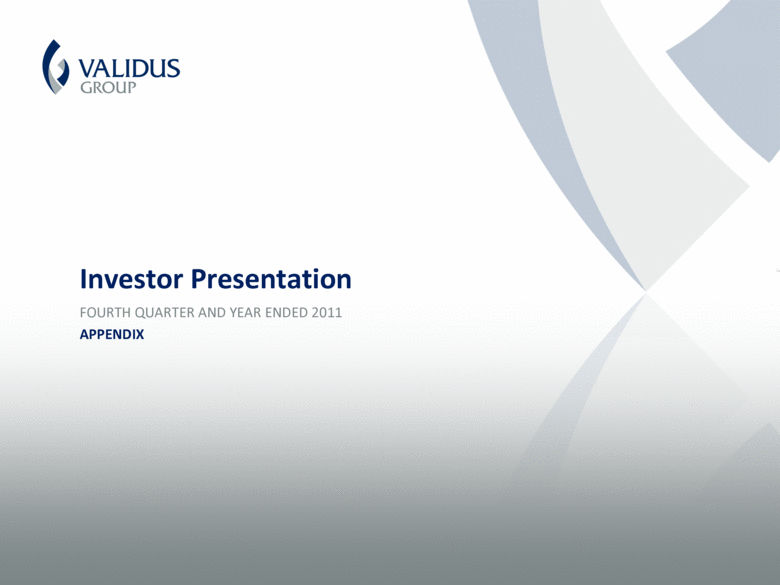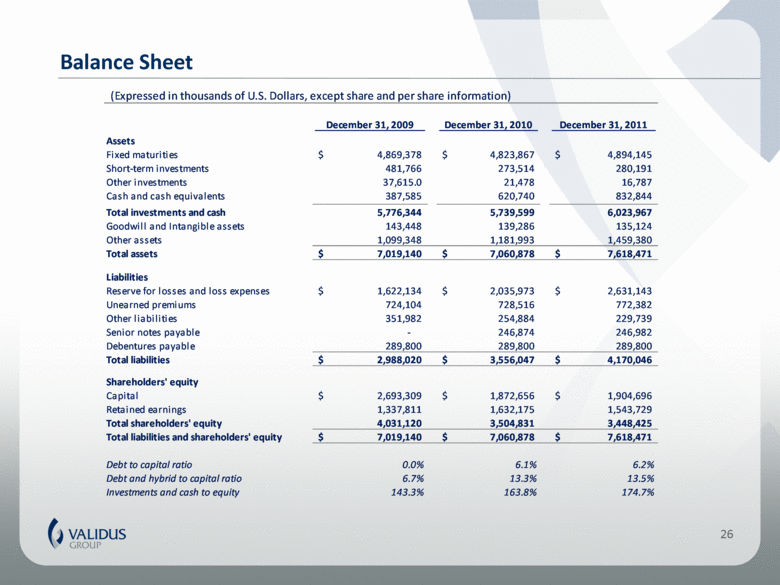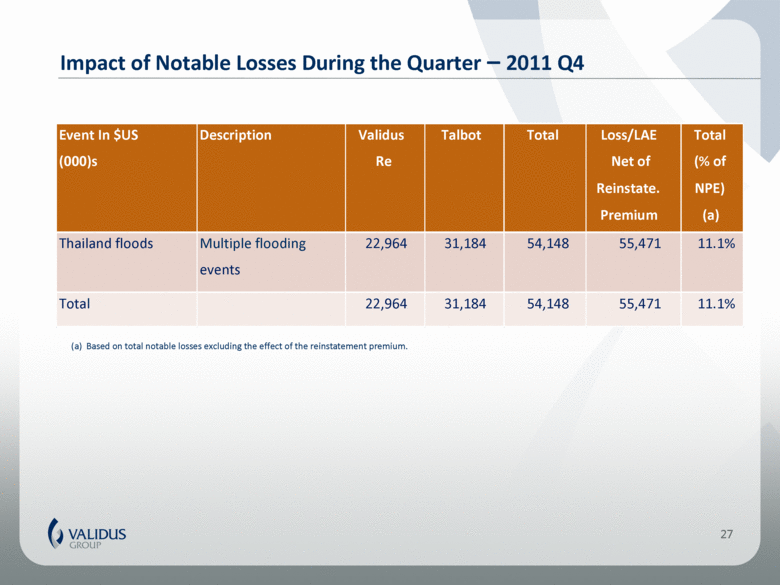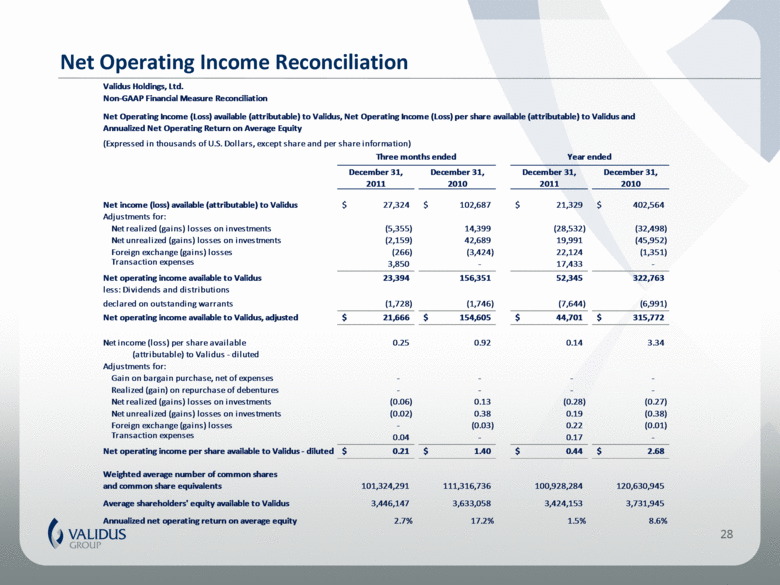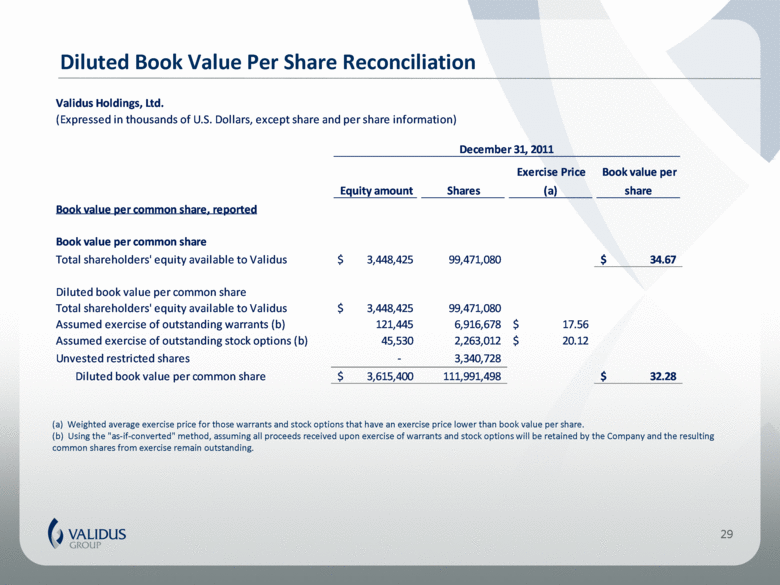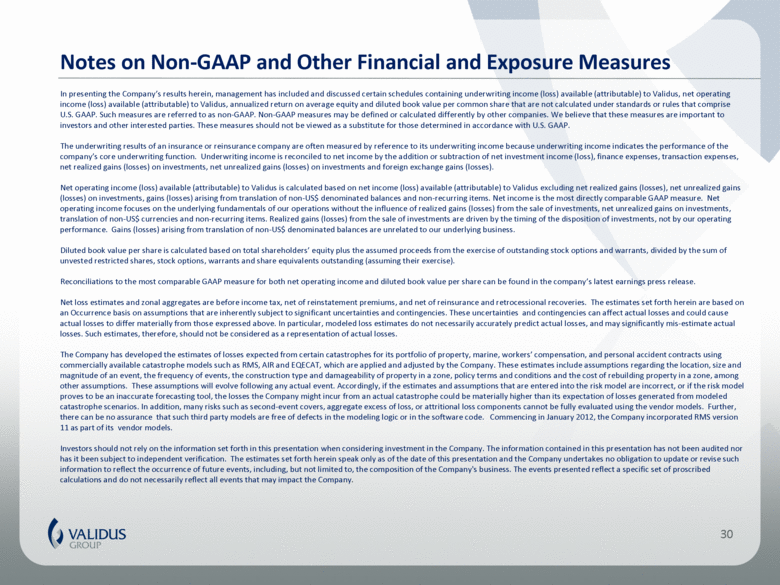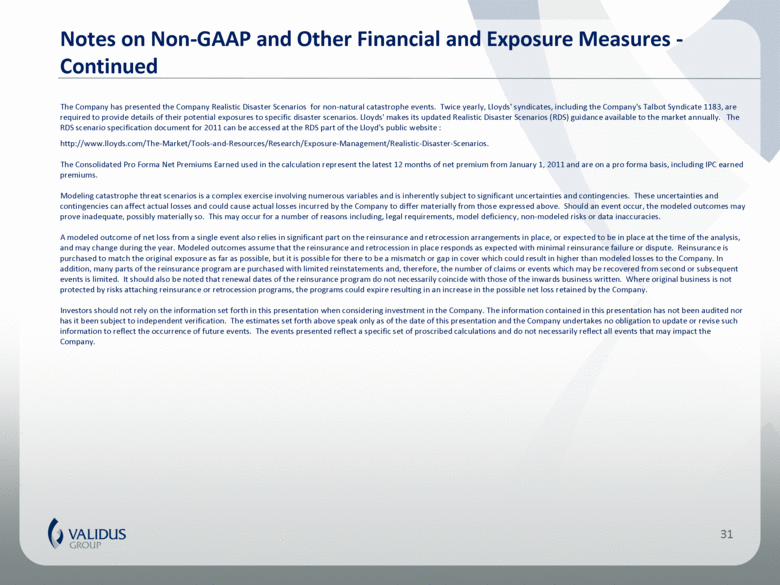Attached files
| file | filename |
|---|---|
| 8-K - 8-K - VALIDUS HOLDINGS LTD | a12-5935_18k.htm |
Exhibit 99.1
|
|
ASSOCIATION OF INSURANCE AND FINANCIAL ANALYSTS CONFERENCE INVESTOR PRESENTATION – FOURTH QUARTER AND YEAR ENDED 2011 Validus Holdings, Ltd. |
|
|
Cautionary Note Regarding Forward-looking Statements This presentation may include forward-looking statements, both with respect to us and our industry, that reflect our current views with respect to future events and financial performance. Statements that include the words “expect,” “intend,” “plan,” “believe,” “project,” “anticipate,” “will,” “may” and similar statements of a future or forward-looking nature identify forward-looking statements. All forward-looking statements address matters that involve risks and uncertainties. Accordingly, there are or will be important factors that could cause actual results to differ materially from those indicated in such statements and, therefore, you should not place undue reliance on any such statements. We believe that these factors include, but are not limited to, the following: 1) unpredictability and severity of catastrophic events; 2) rating agency actions; 3) adequacy of Validus’ risk management and loss limitation methods; 4) cyclicality of demand and pricing in the insurance and reinsurance markets; 5) statutory or regulatory developments including tax policy, reinsurance and other regulatory matters; 6) Validus’ ability to implement its business strategy during “soft” as well as “hard” markets; 7) adequacy of Validus’ loss reserves; 8) continued availability of capital and financing; 9) retention of key personnel; 10) competition; 11) potential loss of business from one or more major insurance or reinsurance brokers; 12) Validus’ ability to implement, successfully and on a timely basis, complex infrastructure, distribution capabilities, systems, procedures and internal controls, and to develop accurate actuarial data to support the business and regulatory and reporting requirements; 13) general economic and market conditions (including inflation, volatility in the credit and capital markets, interest rates and foreign currency exchange rates); 14) the integration of businesses Validus may acquire or new business ventures Validus may start; 15) the effect on Validus’ investment portfolios of changing financial market conditions including inflation, interest rates, liquidity and other factors; 16) acts of terrorism or outbreak of war; and 17) availability of reinsurance and retrocessional coverage, as well as management’s response to any of the aforementioned factors. The foregoing review of important factors should not be construed as exhaustive and should be read in conjunction with the other cautionary statements that are included herein and elsewhere, including the Risk Factors included in our most recent reports on Form 10-K and Form 10-Q and other documents on file with the Securities and Exchange Commission. Any forward-looking statements made in this presentation are qualified by these cautionary statements, and there can be no assurance that the actual results or developments anticipated by us will be realized or, even if substantially realized, that they will have the expected consequences to, or effects on, us or our business or operations. We undertake no obligation to update publicly or revise any forward-looking statement, whether as a result of new information, future developments or otherwise. 2 |
|
|
Selected Market Information at December 31, 2011 Exchange / Ticker: NYSE / “VR” Share Price: $31.50 Primary Shares Outstanding: 99,471,080 Primary Market Capitalization $3.13 billion Annual Dividend/Yield: $1.00 per share (3.17%) Analyst Coverage: Matt Carletti, JMP Securities Jay Cohen, Bank of America Merrill Lynch Dean Evans, Keefe, Bruyette & Woods Julia Ferguson, Dowling & Partners Matt Heimermann, J.P. Morgan Amit Kumar, Macquarie Brian Meredith, UBS Michael Nannizzi, Goldman Sachs Josh Shanker, Deutsche Bank Meyer Shields, Stifel Nicolaus 3 |
|
|
Validus Overview International reinsurance and insurance business Size and scale to compete effectively Two distinct yet complementary operating companies Focused on short-tail classes of reinsurance and insurance Leadership position in property catastrophe reinsurance Profitable in every year since inception Short duration, highly liquid, conservative balance sheet Transparent risk disclosure 4 |
|
|
Global Operating Platform (a) Certain subsidiaries have been excluded for the purposes of presentation. For a complete organizational description see the company’s most recent Annual Report on Form 10-K. (b) AlphaCat Re 2011 Ltd. is a non-consolidated affiliate. 5 Global Presence: Bermuda, Europe, Latin America/Miami, London, Singapore |
|
|
Validus Shareholders’ Equity vs. Selected Peers Peer Comparison – Q4 2011 Common Shareholders’ Equity in $US Billions 6 Source: SNL Financial and company reports 6.1 5.6 4.9 4.1 4.1 3.4 3.1 3.1 2.8 2.8 2.2 1.7 1.5 1.4 0.8 - 1.0 2.0 3.0 4.0 5.0 6.0 7.0 RE PRE AXS ACGL TRH VR AWH RNR ALTE AHL ENH PTP AGII MRH FSR |
|
|
Validus is Focused on Short-Tail Specialty Classes 7 2011 Gross Premium Written of $2.1 billion 96% of Business is Short Tail Property 52% Marine 27% Specialty 21% |
|
|
Validus Reinsurance, Ltd. 8 2011 Gross Premium Written of $1.2 billion Operates in the best priced segments of the reinsurance industry Leadership position in property catastrophe reinsurance $667 million of 2011 property cat GPW Analytics based underwriting culture Experienced underwriting team Quoting market, not a “price taker” Property Cat XOL 56% Other Property 16% Marine 20% Specialty 8% |
|
|
The Property Catastrophe Rate Environment Continues to be Favorable 9 (a) Index value of 100 in 1990. Source: Guy Carpenter U.S. Property Catastrophe Rate on Line Index VR achieved a risk-adjusted 15.7% rate increase at Jan 1, 2012 on the U.S. catastrophe business 111% 133% 152% 173% 154% 145% 255% 233% 195% 215% 190% 184% 199% 100% 125% 150% 175% 200% 225% 250% 275% 2000 2001 2002 2003 2004 2005 2006 2007 2008 2009 2010 2011 1/1/2012 |
|
|
Managed Premiums – Validus and Third Party Capital 10 Jan 1, 2012 and last three quarters growth in managed premiums Writes collateralized, low attachment point retrocessional and similar risks Formed in May 2011 with $185mm of capital, $135mm from third parties $60mm GPW during June-Dec, 2011 December, 2011: $60mm additional capital raise and $11mm of proceeds from the sale of shares $76mm GPW at Jan 1, 2012 Alpha Cat Re 2011 (a) The above table reflects the quarter on quarter growth in Validus Managed Premium since Alpha Cat Re’s inception in Q2 2011. 10.7% 28.2% 20.2% 60.4% 0.0% 10.0% 20.0% 30.0% 40.0% 1/1/12 4Q11 3Q11 2Q11 |
|
|
Talbot Holdings, Ltd. 11 2011 Gross Premium Written of $1.0 billion Well diversified portfolio of short-tail business focused on insurance Leader in the War and Marine classes Most risks are non-U.S. $328 million of reserve releases since 2007 acquisition Provides global licensing and other Lloyd’s benefits Marine 34% Property 20% War 17% Onshore Energy 11% % Aviation 11% Fin. Inst 4% Other 3% |
|
|
2012 Lloyd’s Syndicate Capacities – In US$ Millions 12 Source: Lloyd’s of London, Aon Benfield and Company Reports. Converted at rate of exchange £1.00 = $1.57 Lloyd’s Top 3 Bermuda (Re)Insurers 2,200 1,845 1,670 942 550 471 440 330 314 283 212 165 115 0 500 1,000 1,500 2,000 2,500 |
|
|
Talbot Composite Rate Index – 2000 through 2011 13 (a) Rate index reflects the whole account rate change, as adjusted for changes in exposure, inflation, attachment point and terms and conditions. 100% 126% 187% 208% 206% 204% 218% 207% 197% 209% 209% 215% 75.0% 100.0% 125.0% 150.0% 175.0% 200.0% 225.0% 2000 2001 2002 2003 2004 2005 2006 2007 2008 2009 2010 2011 |
|
|
Transparent Risk Disclosure – January 1, 2012 Portfolio 14 (a) A full explanation and disclaimer is contained in the note on non-GAAP financial and other measures found in the Appendix hereto. (b) Note that the PML data presented reflects the incorporation of RMS 11. Probable Maximum Losses by Zone and Peril Zones Perils 20 year return period 50 year return period 100 year return period 250 year return period Validus Re Net Maximum Zonal Aggregate United States Hurricane 445,374 706,886 888,282 1,091,720 1,641,119 California Earthquake 43,883 135,853 228,565 368,370 1,474,982 Europe Windstorm 143,649 295,831 437,222 627,212 1,500,548 Japan Earthquake 74,999 138,904 167,419 237,769 748,287 Japan Typhoon 27,601 109,098 198,283 273,062 729,693 (Expressed in thousands of U.S. Dollars) Consolidated (Validus Re and Talbot) Estimated Net Loss 1:100 year PML equal to 22.3% of quarter end capital, 25.8% of shareholders’ equity |
|
|
Ratio of 1:100 U.S. Windstorm Risk to Capital Over Time 15 Note that the PML data as of December 2011 reflects the incorporation of RMS 11 0 200 400 600 800 1,000 1,200 1,400 Dec-08 Mar-09 Jun-09 Sep-09 Dec-09 Mar-10 Jun-10 Sep-10 Dec-10 Mar-11 Jun-11 Sep-11 Dec-11 PML/Capital Gross PML Net PML |
|
|
Realistic Disaster Scenarios 16 (a) A full explanation and disclaimer is contained in the note on non-GAAP financial and other measures found in the Appendix hereto. Consolidated (Validus Re and Talbot) Realistic Disaster Scenarios (RDS) Estimates as of July 1, 2011 (Expressed in millions of U.S. Dollars) Type Catastrophe Scenarios Description $ % Terrorism Rockefeller Center Midtown Manhattan suffers a 2-tonne conventional bomb blast 228.8 12.7% Terrorism Exchange Place Lower Manhattan suffers a 2-tonne conventional bomb blast 155.9 8.7% Marine Marine collision in Prince William Sound Fully laden tanker collides with a cruise vessel in Prince William Sound 174.0 9.7% Marine Major cruise vessel incident US-owned cruise vessel sunk or severely damaged 139.4 7.7% Marine Loss of major complex Total loss to all platforms and bridge links of a major oil complex 225.3 12.5% Aviation Aviation collision Collision of two aircraft over a major city 67.1 3.7% Satellite Proton flare Large single or sequence of proton flares results in loss to all satellites in synchronous orbit 25.1 1.4% Satellite Generic defect Undetected defect in a number of operational satellites causing major loss 34.1 1.9% Liability Professional lines Failure or collapse of a major corporation 30.7 1.7% Liability Professional lines UK pensions mis-selling 17.2 1.0% Political Risks South East Asia Chinese economy has a "hard landing" with sharp fall in growth rates; regional contagion 100.9 5.6% Political Risks South America Severe economic crisis in Brazil due to political upheaval; regional contagion 130.6 7.2% Political Risks Middle East US and Iran escalate into military confrontation; regional contagion 147.0 8.2% Political Risks Russia The Russian corporate sector. Effects of crashing commodity and stock prices 45.1 2.5% Political Risks Turkey Severe economic crisis in Turkey due to political upheaval 95.6 5.3% Estimated Consolidated Net Loss (Validus Re and Talbot) |
|
|
Fourth Quarter 2011 Financial Results Quarterly Highlights 17 3.2% ROAE and 2.7% net operating ROAE (a) VR diluted book value per share, operating income and operating ROAE are non-GAAP financial measures. (b) ROAE and operating ROAE are presented on an annualized basis. 97.4% combined ratio (101.0% at Validus Re and 87.4% at Talbot) Net income available to Validus of $27.3 million and diluted EPS of $0.25 Net operating income available to Validus of $23.4 million and diluted operating EPS of $0.21 Diluted book value per share of $32.28 0.9% growth (including dividend) in Q4’11 |
|
|
Validus Holdings, Ltd. – Quarterly Comparison Gross premiums written increased 7.6% to $278.3 million 60.4% increase in Validus Re, largely due to the impact of AlphaCat Re 2011, 1.2% decrease in Talbot Net premiums earned increased 12.8% to $488.3 million 13.3% increase in Validus Re, 12.3% increase in Talbot. AlphaCat Re 2011 and reinstatement premiums drove the increase Net investment income increased from third quarter 2011 by $0.3 million to $28.1 million Annualized effective investment yield increased 4bps to 1.84% 18 (a) Income represents that which is available (attributable) to Validus and excludes that which is available (attributable) to the noncontrolling interest. (b) Q4 2011 impacted by $54.1 million Thailand floods. Q4 2010 impacted by Queensland floods $25.0 million, Political violence $12.5 million, Satellite loss $8.8 million and Financial institution loss $5.5 million. Validus Holdings, Ltd. (Expressed in thousands of U.S. Dollars, except ratios, share and per share information) December 31, December 31, 2011 2010 Gross premiums written $ 278,279 $ 258,731 Net premiums written 261,790 223,355 Net premiums earned 488,346 432,811 Net underwriting income 12,774 139,681 Net investment income 28,080 30,962 Net operating income 31,077 156,351 Net income (a) 27,324 102,687 Diluted net income per share (a) $ 0.21 $ 1.40 Diluted net operating income per share $ 0.25 $ 0.92 Selected Ratios Losses and loss expenses 68.6% 35.9% Policy acquisition costs 16.6% 17.4% General and administrative expenses 12.2% 14.4% Expense ratio 28.8% 31.8% Combined ratio 97.4% 67.7% Impact of identified loss events (b) 11.1% 12.0% Impact of prior period development (favorable)/unfavourable -8.8% -7.1% |
|
|
Profitable in All Six Years of Operation – 2006 Through 2011 2008 The year of the credit crisis and Hurricane Ike Only VR plus 4 of our 14 peers were profitable Only VR and RNR were profitable out of the short-tail peer subgroup 2011 Nearly $110 billion of insured catastrophe losses Again, only VR plus 4 of our 14 peers were profitable Only VR was profitable out of the short-tail peer subgroup (a) Profitability is defined as comprehensive income for 2006 through 2011. (b) SNL Financial does not currently have compressive income for AGII and RNR in 2011. Profitability for AGII and RNR in 2011 is defined as net income. (c) VR Peer group: ACGL, AGII, AHL, ALTE, AWH, AXS, ENH, FSR, MRH, PRE, PTP, RE, RNR, TRH and VR. (d) Short-tail peer subgroup includes: FSR, MRH, RNR and VR. Source: SNL Financial and company reports 19 |
|
|
Growth in Diluted Book Value Per Share Plus Accumulated Dividends 13.3% Compound Annual Growth in Dividend Adjusted Diluted BVPS Through December 31, 2011 20 $16.93 $19.73 $24.00 $24.58 $31.28 $35.46 $35.76 $16.00 $18.00 $20.00 $22.00 $24.00 $26.00 $28.00 $30.00 $32.00 $34.00 $36.00 $38.00 31-Dec-2005 31-Dec-2006 31-Dec-2007 31-Dec-2008 31-Dec-2009 31-Dec-2010 31-Dec-2011 Diluted BV/Sh plus Accumulated Divs |
|
|
Compound Growth in Diluted Book Value per Share – Since Validus IPO 21 (a) VR starting point is Pro Forma diluted BVPS at June 30, 2007 of $20.89 as reported in the IPO Prospectus. (b) Diluted book value per share calculation includes impact of quarterly dividends. Source: SNL Financial and company reports Through December 31, 2011 19.6% 17.0% 14.1% 12.7% 12.2% 11.8% 11.6% 11.3% 10.9% 10.8% 9.6% 9.3% 8.4% 6.6% - 1.5% - 5.0% 0.0% 5.0% 10.0% 15.0% 20.0% AWH ACGL ENH VR AHL PTP RNR AXS PRE TRH MRH AGII RE ALTE FSR |
|
|
Investment Portfolio at December 31, 2011 Total cash and invested assets of $6.02 billion Emphasis on the preservation of invested assets Provision of sufficient liquidity for prompt payment of claims Comprehensive portfolio disclosure Average portfolio rating of AA- Minimum average credit quality of AA- Duration of 1.63 years Quarterly average investment yield: 1.84% 22 22.1% 19.6% 18.5% 9.6% 7.8% 7.8% 7.5% 5.4% 0.5% 0.5% 0.4% 0.3% 0.0% U.S. corporate U.S. Govt. and Agency Short term and cash Non - U.S. corporate Agency RMBS Bank loans Non - U.S. Govt. and Agency ABS Non - Agency RMBS Cat bonds State and local Other CMBS 0% 10% 20% 30% |
|
|
Gross Loss Reserves at December 31, 2011 Observations Gross reserves for losses and loss expenses of $2.63 billion: $2.26 billion net of reinsurance IBNR represents 46.2% of reserves: $54.1 million of notable losses in the 4th quarter, 2011 Talbot has a history of favorable reserve development: $327.8 million since acquisition Favorable reserve development in the quarter of $42.8 million: Talbot favorable development of $35.7 million Validus Re favorable development of $7.1 million 23 Validus Gross Reserve Mix Case Reserves 53.8% IBNR Reserves 46.2% |
|
|
Conclusion – Well Positioned for 2012 and Beyond International reinsurance and insurance business Size and scale to compete effectively Two distinct yet complementary operating companies Focused on short-tail classes of reinsurance and insurance Leadership position in property catastrophe reinsurance Profitable in every year since inception Short duration, highly liquid, conservative balance sheet Transparent risk disclosure 24 |
|
|
FOURTH QUARTER AND YEAR ENDED 2011 APPENDIX Investor Presentation |
|
|
Balance Sheet 26 (Expressed in thousands of U.S. Dollars, except share and per share information) December 31, 2009 December 31, 2010 December 31, 2011 Assets Fixed maturities 4,869,378 $ 4,823,867 $ 4,894,145 $ Short-term investments 481,766 273,514 280,191 Other investments 37,615.0 21,478 16,787 Cash and cash equivalents 387,585 620,740 832,844 Total investments and cash 5,776,344 5,739,599 6,023,967 Goodwill and Intangible assets 143,448 139,286 135,124 Other assets 1,099,348 1,181,993 1,459,380 Total assets 7,019,140 $ 7,060,878 $ 7,618,471 $ Liabilities Reserve for losses and loss expenses 1,622,134 $ 2,035,973 $ 2,631,143 $ Unearned premiums 724,104 728,516 772,382 Other liabilities 351,982 254,884 229,739 Senior notes payable - 246,874 246,982 Debentures payable 289,800 289,800 289,800 Total liabilities 2,988,020 $ 3,556,047 $ 4,170,046 $ Shareholders' equity Capital 2,693,309 $ 1,872,656 $ 1,904,696 $ Retained earnings 1,337,811 1,632,175 1,543,729 Total shareholders' equity 4,031,120 3,504,831 3,448,425 Total liabilities and shareholders' equity 7,019,140 $ 7,060,878 $ 7,618,471 $ Debt to capital ratio 0.0% 6.1% 6.2% Debt and hybrid to capital ratio 6.7% 13.3% 13.5% Investments and cash to equity 143.3% 163.8% 174.7% |
|
|
Impact of Notable Losses During the Quarter – 2011 Q4 27 (a) Based on total notable losses excluding the effect of the reinstatement premium. Event In $US (000)s Description Validus Re Talbot Total Loss/LAE Net of Reinstate. Premium Total (% of NPE) (a) Thailand floods Multiple flooding events 22,964 31,184 54,148 55,471 11.1% Total 22,964 31,184 54,148 55,471 11.1% |
|
|
Net Operating Income Reconciliation 28 Validus Holdings, Ltd. Non-GAAP Financial Measure Reconciliation (Expressed in thousands of U.S. Dollars, except share and per share information) December 31, 2011 December 31, 2010 December 31, 2011 December 31, 2010 Net income (loss) available (attributable) to Validus 27,324 $ 102,687 $ 21,329 $ 402,564 $ Adjustments for: Net realized (gains) losses on investments (5,355) 14,399 (28,532) (32,498) Net unrealized (gains) losses on investments (2,159) 42,689 19,991 (45,952) Foreign exchange (gains) losses (266) (3,424) 22,124 (1,351) Transaction expenses 3,850 - 17,433 - Net operating income available to Validus 23,394 156,351 52,345 322,763 less: Dividends and distributions declared on outstanding warrants (1,728) (1,746) (7,644) (6,991) Net operating income available to Validus, adjusted 21,666 $ 154,605 $ 44,701 $ 315,772 $ Net income (loss) per share available 0.25 0.92 0.14 3.34 (attributable) to Validus - diluted Adjustments for: Gain on bargain purchase, net of expenses - - - - Realized (gain) on repurchase of debentures - - - - Net realized (gains) losses on investments (0.06) 0.13 (0.28) (0.27) Net unrealized (gains) losses on investments (0.02) 0.38 0.19 (0.38) Foreign exchange (gains) losses - (0.03) 0.22 (0.01) Transaction expenses 0.04 - 0.17 - Net operating income per share available to Validus - diluted 0.21 $ 1.40 $ 0.44 $ 2.68 $ Weighted average number of common shares and common share equivalents 101,324,291 111,316,736 100,928,284 120,630,945 Average shareholders' equity available to Validus 3,446,147 3,633,058 3,424,153 3,731,945 Annualized net operating return on average equity 2.7% 17.2% 1.5% 8.6% Net Operating Income (Loss) available (attributable) to Validus, Net Operating Income (Loss) per share available (attributable) to Validus and Annualized Net Operating Return on Average Equity Three months ended Year ended |
|
|
Diluted Book Value Per Share Reconciliation 29 (a) Weighted average exercise price for those warrants and stock options that have an exercise price lower than book value per share. (b) Using the "as-if-converted" method, assuming all proceeds received upon exercise of warrants and stock options will be retained by the Company and the resulting common shares from exercise remain outstanding. Validus Holdings, Ltd. (Expressed in thousands of U.S. Dollars, except share and per share information) Equity amount Shares Exercise Price (a) Book value per share Book value per common share, reported Book value per common share Total shareholders' equity available to Validus 3,448,425 $ 99,471,080 34.67 $ Diluted book value per common share Total shareholders' equity available to Validus 3,448,425 $ 99,471,080 Assumed exercise of outstanding warrants (b) 121,445 6,916,678 17.56 $ Assumed exercise of outstanding stock options (b) 45,530 2,263,012 20.12 $ Unvested restricted shares - 3,340,728 Diluted book value per common share 3,615,400 $ 111,991,498 32.28 $ December 31, 2011 |
|
|
Notes on Non-GAAP and Other Financial and Exposure Measures In presenting the Company’s results herein, management has included and discussed certain schedules containing underwriting income (loss) available (attributable) to Validus, net operating income (loss) available (attributable) to Validus, annualized return on average equity and diluted book value per common share that are not calculated under standards or rules that comprise U.S. GAAP. Such measures are referred to as non-GAAP. Non-GAAP measures may be defined or calculated differently by other companies. We believe that these measures are important to investors and other interested parties. These measures should not be viewed as a substitute for those determined in accordance with U.S. GAAP. The underwriting results of an insurance or reinsurance company are often measured by reference to its underwriting income because underwriting income indicates the performance of the company’s core underwriting function. Underwriting income is reconciled to net income by the addition or subtraction of net investment income (loss), finance expenses, transaction expenses, net realized gains (losses) on investments, net unrealized gains (losses) on investments and foreign exchange gains (losses). Net operating income (loss) available (attributable) to Validus is calculated based on net income (loss) available (attributable) to Validus excluding net realized gains (losses), net unrealized gains (losses) on investments, gains (losses) arising from translation of non-US$ denominated balances and non-recurring items. Net income is the most directly comparable GAAP measure. Net operating income focuses on the underlying fundamentals of our operations without the influence of realized gains (losses) from the sale of investments, net unrealized gains on investments, translation of non-US$ currencies and non-recurring items. Realized gains (losses) from the sale of investments are driven by the timing of the disposition of investments, not by our operating performance. Gains (losses) arising from translation of non-US$ denominated balances are unrelated to our underlying business. Diluted book value per share is calculated based on total shareholders’ equity plus the assumed proceeds from the exercise of outstanding stock options and warrants, divided by the sum of unvested restricted shares, stock options, warrants and share equivalents outstanding (assuming their exercise). Reconciliations to the most comparable GAAP measure for both net operating income and diluted book value per share can be found in the company’s latest earnings press release. Net loss estimates and zonal aggregates are before income tax, net of reinstatement premiums, and net of reinsurance and retrocessional recoveries. The estimates set forth herein are based on an Occurrence basis on assumptions that are inherently subject to significant uncertainties and contingencies. These uncertainties and contingencies can affect actual losses and could cause actual losses to differ materially from those expressed above. In particular, modeled loss estimates do not necessarily accurately predict actual losses, and may significantly mis-estimate actual losses. Such estimates, therefore, should not be considered as a representation of actual losses. The Company has developed the estimates of losses expected from certain catastrophes for its portfolio of property, marine, workers’ compensation, and personal accident contracts using commercially available catastrophe models such as RMS, AIR and EQECAT, which are applied and adjusted by the Company. These estimates include assumptions regarding the location, size and magnitude of an event, the frequency of events, the construction type and damageability of property in a zone, policy terms and conditions and the cost of rebuilding property in a zone, among other assumptions. These assumptions will evolve following any actual event. Accordingly, if the estimates and assumptions that are entered into the risk model are incorrect, or if the risk model proves to be an inaccurate forecasting tool, the losses the Company might incur from an actual catastrophe could be materially higher than its expectation of losses generated from modeled catastrophe scenarios. In addition, many risks such as second-event covers, aggregate excess of loss, or attritional loss components cannot be fully evaluated using the vendor models. Further, there can be no assurance that such third party models are free of defects in the modeling logic or in the software code. Commencing in January 2012, the Company incorporated RMS version 11 as part of its vendor models. Investors should not rely on the information set forth in this presentation when considering investment in the Company. The information contained in this presentation has not been audited nor has it been subject to independent verification. The estimates set forth herein speak only as of the date of this presentation and the Company undertakes no obligation to update or revise such information to reflect the occurrence of future events, including, but not limited to, the composition of the Company's business. The events presented reflect a specific set of proscribed calculations and do not necessarily reflect all events that may impact the Company. 30 |
|
|
Notes on Non-GAAP and Other Financial and Exposure Measures - Continued The Company has presented the Company Realistic Disaster Scenarios for non-natural catastrophe events. Twice yearly, Lloyds' syndicates, including the Company's Talbot Syndicate 1183, are required to provide details of their potential exposures to specific disaster scenarios. Lloyds' makes its updated Realistic Disaster Scenarios (RDS) guidance available to the market annually. The RDS scenario specification document for 2011 can be accessed at the RDS part of the Lloyd's public website : http://www.lloyds.com/The-Market/Tools-and-Resources/Research/Exposure-Management/Realistic-Disaster-Scenarios. The Consolidated Pro Forma Net Premiums Earned used in the calculation represent the latest 12 months of net premium from January 1, 2011 and are on a pro forma basis, including IPC earned premiums. Modeling catastrophe threat scenarios is a complex exercise involving numerous variables and is inherently subject to significant uncertainties and contingencies. These uncertainties and contingencies can affect actual losses and could cause actual losses incurred by the Company to differ materially from those expressed above. Should an event occur, the modeled outcomes may prove inadequate, possibly materially so. This may occur for a number of reasons including, legal requirements, model deficiency, non-modeled risks or data inaccuracies. A modeled outcome of net loss from a single event also relies in significant part on the reinsurance and retrocession arrangements in place, or expected to be in place at the time of the analysis, and may change during the year. Modeled outcomes assume that the reinsurance and retrocession in place responds as expected with minimal reinsurance failure or dispute. Reinsurance is purchased to match the original exposure as far as possible, but it is possible for there to be a mismatch or gap in cover which could result in higher than modeled losses to the Company. In addition, many parts of the reinsurance program are purchased with limited reinstatements and, therefore, the number of claims or events which may be recovered from second or subsequent events is limited. It should also be noted that renewal dates of the reinsurance program do not necessarily coincide with those of the inwards business written. Where original business is not protected by risks attaching reinsurance or retrocession programs, the programs could expire resulting in an increase in the possible net loss retained by the Company. Investors should not rely on the information set forth in this presentation when considering investment in the Company. The information contained in this presentation has not been audited nor has it been subject to independent verification. The estimates set forth above speak only as of the date of this presentation and the Company undertakes no obligation to update or revise such information to reflect the occurrence of future events. The events presented reflect a specific set of proscribed calculations and do not necessarily reflect all events that may impact the Company. 31 |

